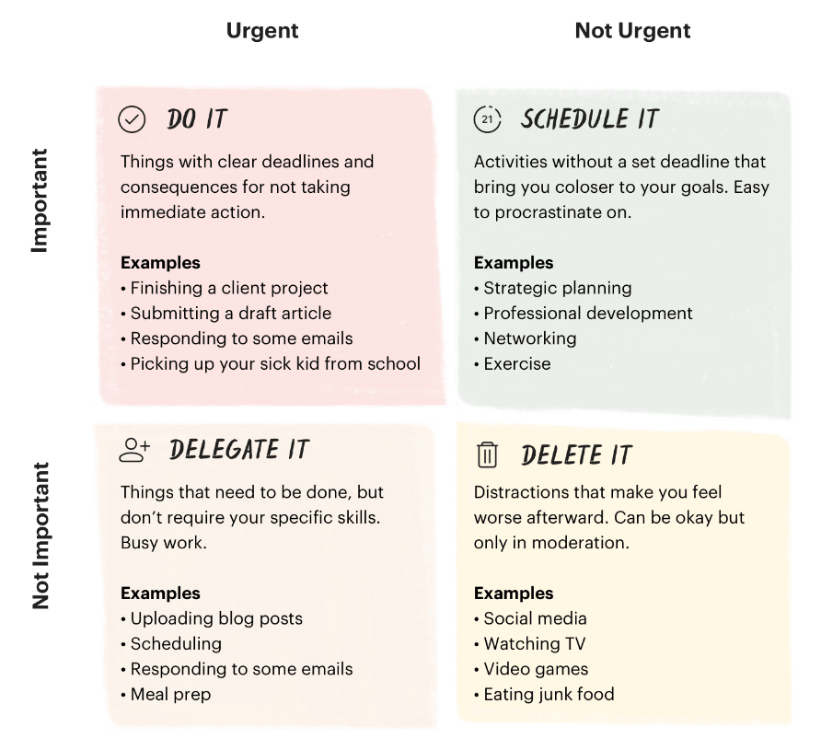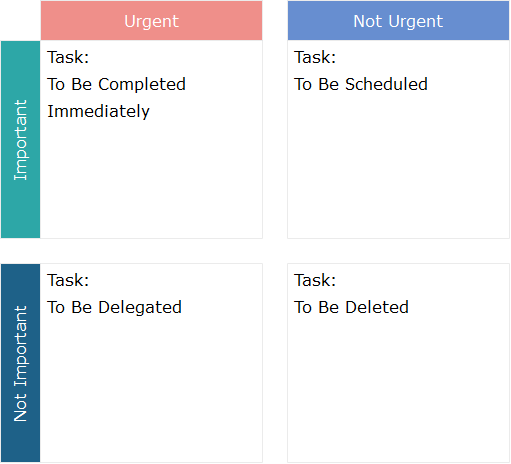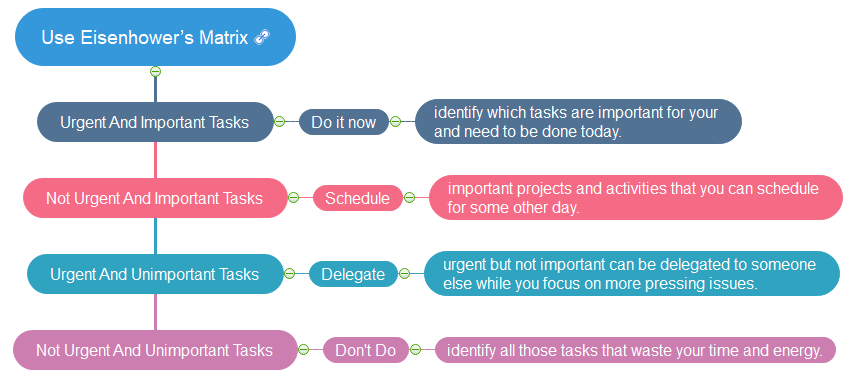Eisenhower's Urgent-Important Matrix

Being busy and overworked is bad enough, but being busy and overworked with an unorganized schedule is even worse. Are you always on your toes trying to finish one task after another? Managing multiple things at once? It is frustrating and makes you anxious? You are juggling so many things that once that your brain can't properly concentrate?
There's a simple solution to all these problems – Eisenhower's Urgent/Important Matrix. This tool will help manage all your tasks and improve productivity by organizing your schedule efficiently!
If this grabbed your attention, continue reading to find out what Eisenhower's Urgent/Important Matrix is.
What is Eisenhower’s Matrix?
The Eisenhower Matrix is a diagrammatic tool to help you visualize all your daily tasks in the form of a matrix that categorizes them based on urgency and importance.
Eisenhower’s matrix is inspired by Dwight Eisenhower, the 34th President and Army General of the United States. During a speech in 1954, Eisenhower quoted J.Roscoe Miller, President of Northwestern University:
“I have two kinds of problems, the urgent and the important. The urgent are not important, and the important are never urgent.”
In the best-selling book "The 7 Habits of Highly Effective People," Stephen Covey presented a tool to prioritize tasks. This tool was based on Eisenhower's insights and is now called the Eisenhower Matrix. It is also known as The Urgent Important Matrix, Time Management Matrix, The Eisenhower Box, and The Eisenhower Method.
The Eisenhower Matrix distributes all the tasks and projects into 4 quadrants, i.e.:
- Urgent and Important Tasks
- Not Urgent and Important Tasks
- Urgent and Unimportant Tasks
- Not Urgent and Unimportant Tasks

Source: todoist.com
Let’s take a closer look at these categories.
What Are “Urgent” and “Important” Activities?
Urgent – Such tasks and activities are those that require immediate action. These issues demand your attention NOW. A simple way to recognize urgent activities is to always come with their consequences for not completing the task quickly. These tasks are unavoidable under current circumstances.
Important – important matters and tasks that directly contribute to the long-term goals and values. Therefore, these tasks require thoughtful planning and actions. They also demand time management, energy, and attention, which are subjective and depend on our values and goals.
Here is how you can correctly identify tasks as "Urgent" and "Important" and further classify them under the four quadrants of the urgent/important matrix:
1. Urgent And Important Tasks (To Be Completed Immediately)
Quadrant 1 tasks are inevitable. Deleting these tasks or spending too much time on them will only lead to stress and fatigue. So, it is recommended to make these tasks a priority and finish them as soon as possible.
These items usually have a visible deadline and precautions for not taking immediate action, such as last-minute projects, solving a pressing problem for a client, or car stalls on the highway.
2. Not Urgent And Important Tasks (Projects To Be Scheduled)
Quadrant 2 tasks are important and help you achieve long term goals, but they do not have a deadline, so they can easily be put off to favor more urgent tasks—for example, professional networking, maintenance projects, or learning a new skill.
3. Urgent And Unimportant Tasks (To Be Delegated)
These tasks are described as "busy work." These tasks are not meaningful to you, and they can be delegated to someone else to finish them on time. For example, responding to client messages, acting on coupons, checking emails, etc.
4. Not Urgent And Unimportant Tasks (To Be Deleted)
These are time-wasting activities that don't contribute to any progress on your goals. The key is to limit your time to such activities. For example, mindlessly scrolling through social media, watching TV for hours, and excessive shopping.

How to Use Eisenhower’s Urgent-Important Matrix?
Eisenhower Matrix enables you to prioritize tasks by agency and importance into four different categories that create a seamless and manageable schedule. With the help of this schedule, you can manage your work efficiently and effectively.
To use this matrix, you first need to identify which tasks are important for your and need to be done today. By doing so, it will help you identify the important projects and activities that you need to do first and that you can schedule for some other day.
You will note the urgent and important activities in quadrant 1 to do first. Whereas, the not urgent and important activities go on 2nd quadrant. You can name this quadrant “Schedule.”
Then we have those tasks that are urgent but not important. Therefore, they can be delegated to someone else while you focus on more pressing issues. All such tasks are placed in quadrant 3, which can also be named as "Delegate."
Finally, there are those tasks that are not important. So, you needn't do them. You can name this quadrant as "Don't Do." This quadrant allows you to identify all those tasks that waste your time and energy. By listing them down, you will be more mindful of not indulging in such activities. It can help you stop bad habits like excessive Internet surfing.
Once you have created your urgent/important matrix, your life will become very organized and efficient.

Tips for Using Eisenhower’s Matrix
Here are some simple management steps to help you use the Eisenhower matrix more effectively:
Limit your tasks – don't overexert yourself and try to limit your tasks to a maximum of 8 per quadrant. Before you add another one, make sure you have completed the most important one first. Remember that this matrix helps you finish tasks but not to pile them up.
Avoid distractions – make sure you plan your matrix without any distractions. Do not let someone else define your priorities. Plan your tasks based on your own schedule and energy levels.
Separate personal and business tasks – do not mix your private activities with professional tasks. Create two separate lists for each one. In this way, you will never have to complain about not being able to manage time between your personal and professional life.

